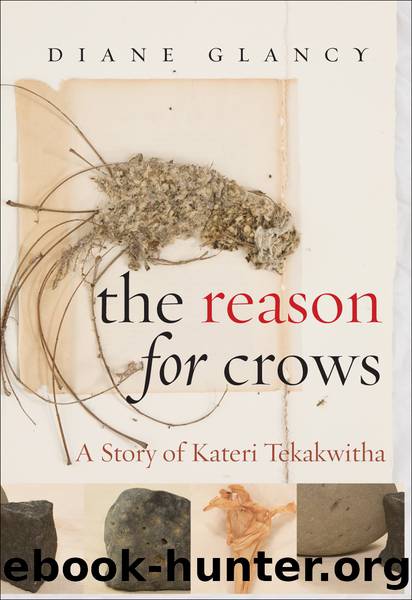The Reason for Crows by Glancy Diane;

Author:Glancy, Diane;
Language: eng
Format: epub
Publisher: State University of New York Press
Published: 2009-08-15T00:00:00+00:00
AFTERWORD
Historical fiction: isnât the term itself an oxymoron?
âTruth or Whoppers: On Writing Historical Fiction, Valerie Martin
IT WAS JUST BEFORE Christmas, December 20, 2005, that the first lines for this book came to me: The moaning was my first memory. I think it was themâmy mother and father. I looked up information on Kateri Tekakwitha on the Internet. I got a book from the library, Mohawk Saint by Allan Greer. I got other books. On January 1, I went to my cabin in the Missouri Ozarks and continued writing and reading. I found the usual discrepancies of history. Tekakwithaâs name was Ka teri. Her name was Kat er ee. Her name was Got ah lee. She was four or six when her parents died. Certain information disagreed. But the story was there: a Mohawk girl suffered smallpox as a child. She was converted to the faith the Jesuits brought. She died at age twenty-four. She appears on the lower left panel of the front doors of St. Patrickâs Cathedral in New York City as Ven. Kateri Tekakwitha. The smallpox scars are visible on her face. A print by Father John B. Giuliani, Blessed Kateri Tekakwitha, appears on the cover of Flutie, another book of mine.
In May 2006, I drove from Kansas City to upstate New York and Montreal to visit Ossernon and both Caughnawagas. Seven hundred thirty-two miles the first day; five hundred thirty-two miles the second; and three hundred two miles the third. I stopped in Auriesville, N.Y., the site of Ossernon, the village where Kateri was born, on a hill above the Mohawk River. I visited the museum. Then I crossed the river at Fonda, N.Y., off U.S. Iâ90, where her people had moved to a new village, Caughnawaga, also on a hill, upstream, on the other side of the Mohawk. I visited another museum and walked up a hill where stakes outlined the site where the village had been. A sign pointed the way to the spring that had provided water for the village and Kateriâs baptism. In the field I passed, I found a single cut lily lying on the ground. Later in the afternoon, I drove to Kahnawake on the south bank of the St. Lawrence River, Montreal.
While I traveled, I listened to books on tape. I took notes on the landscape of upstate New Yorkâthe rock outcroppings were nearly black, much darker than the limestone embankments in the Midwest. I thought about Kateri. I remembered once reading an essay about a woman who stopped for prayer, keeping hours. Even if she was driving, she pulled off the road. My prayer, on the contrary, happens in moving. I write while travelingâI took note of the hills and forest surrounding the Mohawk River. I took note of the level plain of Canada by the St. Lawrence River.
One of the essays I listened to on tape was John Muirâs âStickeen,â about his 1880 exploration of southeastern Alaska, in what is now Taylor Bay. He wrote of crossing a high, narrow ice bridge over a crevasse with a dog, Stickeen.
Download
This site does not store any files on its server. We only index and link to content provided by other sites. Please contact the content providers to delete copyright contents if any and email us, we'll remove relevant links or contents immediately.
| African American | Asian American |
| Classics | Anthologies |
| Drama | Hispanic |
| Humor | Native American |
| Poetry | Southern |
Crazy Rich Asians by Kevin Kwan(9105)
How to Bang a Billionaire by Alexis Hall(8022)
Giovanni's Room by James Baldwin(7096)
Little Fires Everywhere by Celeste Ng(7043)
Win Bigly by Scott Adams(7022)
Tease (Temptation Series Book 4) by Ella Frank(5547)
Pachinko by Min Jin Lee(5502)
The Fire Next Time by James Baldwin(5185)
The Perks of Being a Wallflower by Stephen Chbosky(4514)
China Rich Girlfriend by Kwan Kevin(4441)
Bluets by Maggie Nelson(4420)
First Position by Melissa Brayden(4365)
The Sympathizer by Viet Thanh Nguyen(4249)
Rich People Problems by Kevin Kwan(4211)
A Little Life (2015) by Hanya Yanagihara(4123)
Right Here, Right Now by Georgia Beers(4051)
Walking by Henry David Thoreau(3844)
Catherine Anderson - Comanche 03 by Indigo Blue(3524)
I'll Catch You by Farrah Rochon(3485)
